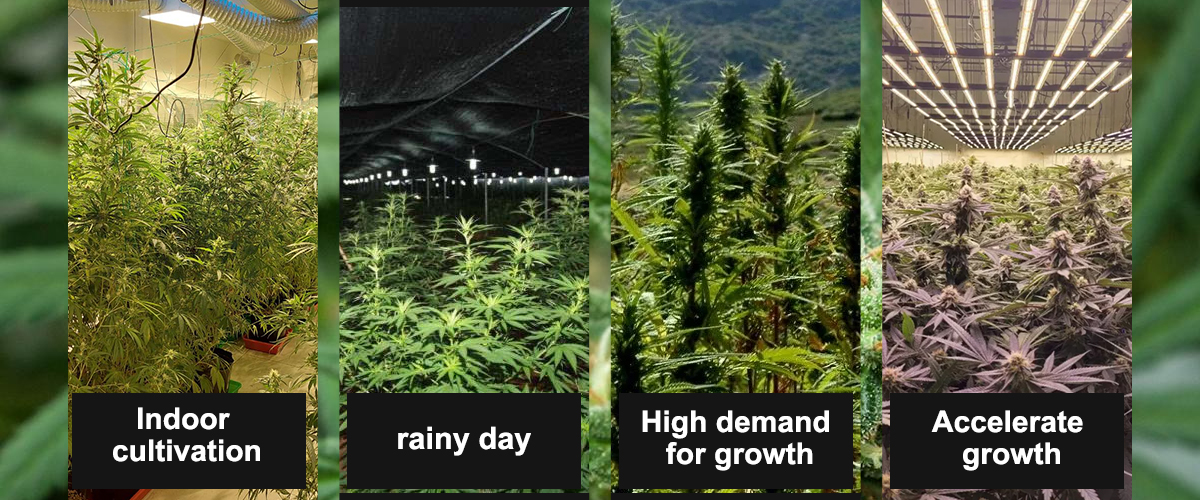Plant grow lights are artificial light sources designed to simulate natural sunlight, helping plants perform photosynthesis in indoor environments or areas with insufficient natural light. These lights typically use technologies like LEDs (Light Emitting Diodes), fluorescent lamps, or HID (High-Intensity Discharge) lamps, each offering unique spectral outputs to optimize plant growth and development.
Why Use Grow Lights?

Plants rely heavily on adequate and appropriate lighting for healthy growth. Light not only promotes photosynthesis but also affects plant respiration, water absorption, and various biochemical reactions. Here’s why supplemental lighting is essential for plants:
Optimize Photosynthesis: Photosynthesis is the process through which plants convert light energy into chemical energy, supplying the energy needed for growth and producing oxygen. Supplemental lighting helps maintain a stable rate of photosynthesis, ensuring continuous energy supply in low-light environments.
Promote Growth and Development: Proper lighting can accelerate plant growth and enhance the development of roots and foliage. This is particularly crucial during the seedling stage of plants.
Influence Flowering and Fruit Production: Photoperiod (the length of day and night) directly affects the flowering times of certain plants. Adjusting grow light usage can manipulate the flowering cycles, especially in photoperiod-sensitive crops like certain orchids and chrysanthemums.
Prevent Diseases and Pests: Insufficient light may reduce a plant’s resistance, making it more susceptible to diseases and pests. Adequate supplemental lighting can strengthen plants’ natural defenses and reduce the occurrence of these issues.
When Do Plants Need Supplemental Lighting?

The need for grow lights is not universal but becomes essential under certain conditions to ensure healthy plant growth:
Indoor Gardening: In indoor settings, especially where natural light is weak or absent, grow lights are almost essential. For instance, offices, dark corners at home, or basements without sufficient windows would require supplemental lighting to mimic natural sunlight for normal photosynthesis.
Winter or Cloudy Days: During winter, shorter daylight hours and lower light intensity mean many plants can’t get enough light for normal growth. Also, prolonged cloudy weather significantly reduces sunlight exposure. Grow lights can help fill the gap during these periods.
High Light Requirement Plants: Some plants, like succulents, tropical plants, or certain herbs, have higher light needs. Without adequate light, these plants might not thrive or produce flowers and fruits. Grow lights ensure these plants receive the necessary light to stay healthy and vibrant.
Accelerating Growth Cycles: In commercial agriculture or for enthusiasts aiming to speed up plant growth cycles for quicker harvests, supplemental lights provide additional light to hasten maturity, particularly important for short lifecycle plants like lettuce or herbs.
Choosing and Using Grow Lights Effectively

When selecting grow lights, understanding and applying the concept of Photosynthetic Photon Flux Density (PPFD) is key. PPFD measures the number of photons reaching a plant’s surface per square meter per second, expressed in micromoles per square meter per second (μmol/m²/s).
This metric is crucial to determine if the light can meet a plant’s requirements. Here’s how to choose the right grow light based on plant type, growth stage, and environmental conditions:
Understanding plant needs for PPFD:
Different plants and growth stages require varying PPFD levels:
Low-light plants (e.g., ferns, some foliage plants) thrive in shaded conditions naturally and need PPFD levels between 100-200 μmol/m²/s.
Moderate-light plants (e.g., African violets, carnivorous plants) require more light, with suitable PPFD ranging from 200-400 μmol/m²/s.
High-light plants (e.g., succulents, tomatoes) grow in full sunlight and generally need PPFD over 400 μmol/m²/s, some even requiring up to 800 μmol/m²/s or more.
Select Appropriate Grow Lights:
LED: Suitable for most indoor plants as they can provide a range from low to high PPFD, are energy-efficient, and produce low heat.
HID: Best for high PPFD-demanding plants, such as edible and ornamental plants requiring intense light. HID lamps offer high-intensity lighting but consume more energy and generate more heat.
Fluorescent: Ideal for beginners and low-light plants, particularly seedlings, as they provide even, low to moderate PPFD.
Consider the Growing Environment:
Indoor Conditions: The choice of grow light should also consider the specific indoor environment. For example, plants in enclosed indoor spaces might need higher PPFD lamps to compensate for the lack of natural light.
Seasonal Changes: Seasonal variations are also crucial. In winter or cloudy weather, even outdoor plants may need supplemental lighting, necessitating lamps that can offer higher PPFD.
Installation and Usage:
Proper Installation: Ensure the lights are installed at an appropriate distance from the plants, typically adjusted based on the plant’s light requirements and the light output of the lamps. Higher PPFD lamps should be placed further from the plants to prevent light burn.
Timed Usage: Using timers to control the grow lights can simulate natural light patterns, helping plants maintain their natural physiological rhythms.
By following these guidelines, you can select suitable grow lights for various indoor plants, ensuring they receive appropriate light at different growth stages and under varying conditions, promoting healthy growth. If you want to learn more about grow lights and techniques, feel free to contact us through the dialogue box below.























